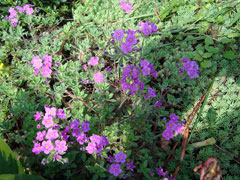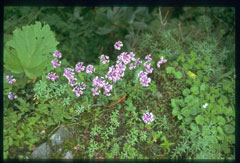 |
|
http://commons.wikimedia.org/wiki/User:IKAl |
 |
| http://androsace.com/?c=The+Himalayas&sticky=c |
Translate this page:
Summary
Physical Characteristics

 Androsace sarmentosa is a PERENNIAL growing to 0.1 m (0ft 4in) by 0.2 m (0ft 8in).
Androsace sarmentosa is a PERENNIAL growing to 0.1 m (0ft 4in) by 0.2 m (0ft 8in).
See above for USDA hardiness. It is hardy to UK zone 3. It is in flower from July to August. The species is hermaphrodite (has both male and female organs).
Suitable for: light (sandy) and medium (loamy) soils, prefers well-drained soil and can grow in nutritionally poor soil. Suitable pH: basic (mildly alkaline) soils and can grow in very alkaline soils.
It can grow in semi-shade (light woodland) or no shade. It prefers dry or moist soil.
UK Hardiness Map
US Hardiness Map
Synonyms
Plant Habitats
Ground Cover; Cultivated Beds; East Wall. In. South Wall. In. West Wall. In.
Edible Uses
References More on Edible Uses
Medicinal Uses
Plants For A Future can not take any responsibility for any adverse effects from the use of plants. Always seek advice from a professional before using a plant medicinally.
Resolvent
The entire plant is used in Tibetan medicine, it is said to have a bitter taste and a cooling and coarsening potency[241]. A resolutive, it dries up serous fluids[241]. It is used in the treatment of disorders from tumours, inflammations of fluids and other serous fluid disorders[241].
References More on Medicinal Uses
The Bookshop: Edible Plant Books
Our Latest books on Perennial Plants For Food Forests and Permaculture Gardens in paperback or digital formats.

Edible Tropical Plants
Food Forest Plants for Hotter Conditions: 250+ Plants For Tropical Food Forests & Permaculture Gardens.
More

Edible Temperate Plants
Plants for Your Food Forest: 500 Plants for Temperate Food Forests & Permaculture Gardens.
More

More Books
PFAF have eight books available in paperback and digital formats. Browse the shop for more information.
Shop Now
Other Uses
Can be used as a low-growing ground cover[200].
Special Uses
Ground cover
References More on Other Uses
Cultivation details
Requires a very well-drained light or sandy alkaline soil of low nutrient status and with the addition of limestone chippings if necessary[200]. Usually best in full sun, though in hot-summer areas it can be better if given some shade, especially from the hottest sun[200]. Grows well on dry stone walls, or as a low ground cover, and tolerates hot humid summers[200].
References Carbon Farming Information and Carbon Sequestration Information
Temperature Converter
Type a value in the Celsius field to convert the value to Fahrenheit:
Fahrenheit:
The PFAF Bookshop
Plants For A Future have a number of books available in paperback and digital form. Book titles include Edible Plants, Edible Perennials, Edible Trees,Edible Shrubs, Woodland Gardening, and Temperate Food Forest Plants. Our new book is Food Forest Plants For Hotter Conditions (Tropical and Sub-Tropical).
Shop Now
Plant Propagation
Seed - requires a period of cold stratification. Where possible, the seed is best sown as soon as it is ripe in a cold frame - all watering should be from the bottom of the pot[200]. The seed can take 2 years to germinate, prick out the seedlings into individual pots as soon as they are large enough to handle and grow on in a partially shaded cold frame[200]. Plant out in late spring or early summer. Division of runners in early summer. Pot them up into a sandy compost and grow them on until they are well-rooted before planting them into their permanent positions[200].
Other Names
If available other names are mentioned here
Native Range
Coming Soon
Weed Potential
Right plant wrong place. We are currently updating this section.
Please note that a plant may be invasive in one area but may not in your area so it's worth checking.
Conservation Status
IUCN Red List of Threatened Plants Status :

Growth: S = slow M = medium F = fast. Soil: L = light (sandy) M = medium H = heavy (clay). pH: A = acid N = neutral B = basic (alkaline). Shade: F = full shade S = semi-shade N = no shade. Moisture: D = dry M = Moist We = wet Wa = water.
Now available:
Food Forest Plants for Mediterranean Conditions
350+ Perennial Plants For Mediterranean and Drier Food Forests and Permaculture Gardens.
[Paperback and eBook]
This is the third in Plants For A Future's series of plant guides for food forests tailored to
specific climate zones. Following volumes on temperate and tropical ecosystems, this book focuses
on species suited to Mediterranean conditions—regions with hot, dry summers and cool, wet winters,
often facing the added challenge of climate change.
Read More
Expert comment
Author
Wall.
Botanical References
200266
Links / References
For a list of references used on this page please go here
Readers comment
| Add a comment |
|
If you have important information about this plant that may help other users please add a comment or link below. Only comments or links that are felt to be directly relevant to a plant will be included. If you think a comment/link or information contained on this page is inaccurate or misleading we would welcome your feedback at [email protected]. If you have questions about a plant please use the Forum on this website as we do not have the resources to answer questions ourselves.
* Please note: the comments by website users are not necessarily those held by PFAF and may give misleading or inaccurate information.
To leave a comment please Register or login here All comments need to be approved so will not appear immediately.
|
Subject : Androsace sarmentosa
|
|
|
|